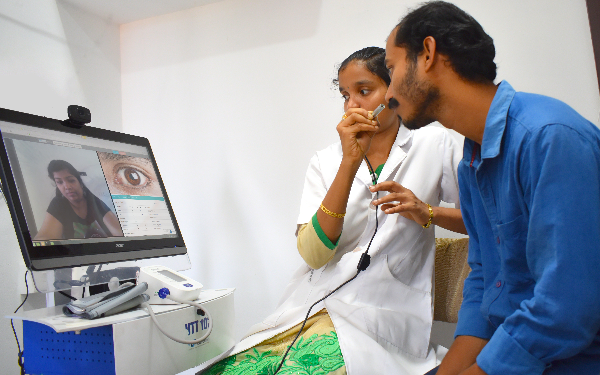
Epionex Health Care Grid (with MyDoc24x7 Mobile App and UTM Telemedicine Cart)
The most important business opportunity currently is the generation of a high band-width virtual telemedicine pathway to connect collaborating hospitals in a hub and spoke model. The Hub hospitals are major hospitals with many specialists and facilities. The spoke hospitals are either (1) small clinics with a few doctors (2) health related support service providers like medical shops or clinical laboratories (3) digital service centres like Akshya. Any one visiting a spoke clinic can get tele-consultation services from any of the connected hub hospitals. The spoke clinic will act as out-reach units of connected hub hospitals. The Epionex portal running on the computer system at both locations has a help desk screen to assist the selection of doctor. A patient can connect to the spoke hospital either through video conferencing using the MyDoc24x7 mobile app or by an actual visit. The spoke clinic will be able to select any of the available doctors in the connected hub hospital. This is required only during the first consultation. Continued consultation will normally with the same doctor. The consultation scheduling for this will be coordinated by the spoke clinic operator using the functions provided in the help desk. Each hub hospital would eventually require a UTM cart so that the functions of tele-stethoscope, close examination camera and ECG can be provided to the clients. Thus, there is potential for exponential growth, once the market picks up. Only 50 words An emerging business opportunity is hub and spoke hospitals. The Hub hospitals are major hospitals. The spoke hospitals are either (1) small clinics (2) support service providers like medical shops or clinical laboratories (3) digital service centres like Akshya. They can provide tele-consultation services from hub hospitals.
Website : https://www.youtube.com/channel/UCgGHyFKNJcSJCTZhjeypXIQ
Current Status: Early revenues
Business Model: B2B
Product Description
The main components of Epionex Care Grid are:
• Epionex Portal: This is the coordinating entity that runs 24x7 from the cloud. All transactions are stored here.
• LVCS: This is a laptop with embedded application software provided to individual doctors operating from homes. It features a video conferencing facility, tele-stethoscope and management software for patient interaction.
• MyDoc24x7: These are mobile applications running in the smart phone of Patient / Doctor. It provides them 24x7 connectivity to the care grid.
• UTM: This is a portable tele-medicine cart that can be taken to home of the patient or left at a local clinic. It features 14” touch screen monitor or a tablet PC, tele-stethoscope, tele-ECG, Vital monitors, and a close examination camera. The software is icon based and intuitive. There are two models – Suitcase version and cart version. The suitcase version uses tablet PC and cart version the touch screen monitor. Suitcase model can be easily carried by the nurse in a motor cycle. Both versions are very similar in functions. The suitcase model is preferred for home care visit. The cart version is preferred for remote clinics.
• MVCS: This is the main video-conferencing system in referral hospitals. If features 50” professional display, mike, speaker, tele-stethoscope and the management software for patient interaction.
With this set-up, patient/doctor consultation over the internet is seem-less. It starts with the registration of the patient onto the portal. During this time the Electronic Health Record (EHR) is captured onto the portal and the MyDoc24x7 mobile application is placed onto the smart phone of the patient. Subsequent transactions from this phone automatically links to this EHR.
All doctors registered onto the grid gets the MyDoc24x7 application installed in their smart phone. Additionally, they will have the LVCS set-up in their home for detailed consultation sessions from there. The hospitals participating in this grid will have MVCS system installed in a common location easily accessible to specialist consultants. This is a generalized Video-conferencing facility with 50-inch professional display, HD camera, hand-held mike, separate speaker, and tele-stethoscope.
The UTM tele-medicine cart is the main unit for interaction between the nurse in the remote location (home or peripheral center) and the doctor in the hospital (with MVCS) or home (with LVCS). It has a wearable ECG unit for continuous monitoring. Additionally, it has tele-stethoscope, vital monitoring devices, and close examination camera. It creates an environment by which, the remote clinical staff can immediately attend to the patient over the MVCS. The unit can be left in the home of the patient to facilitate patient management with advice from clinical staff from specialty hospital or from the home of the treating doctor.
